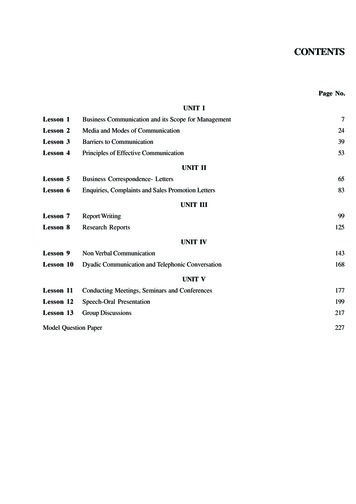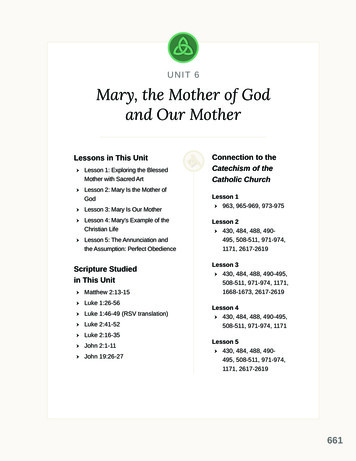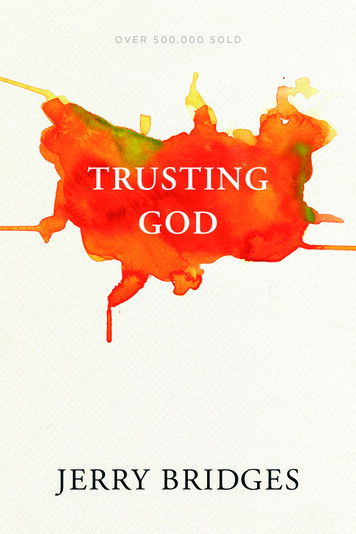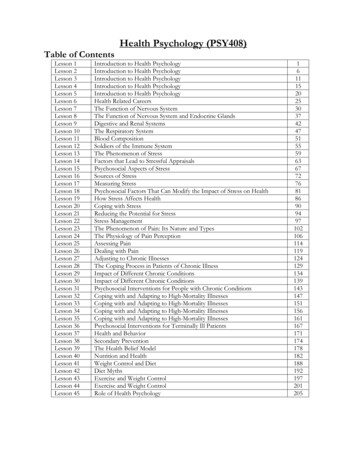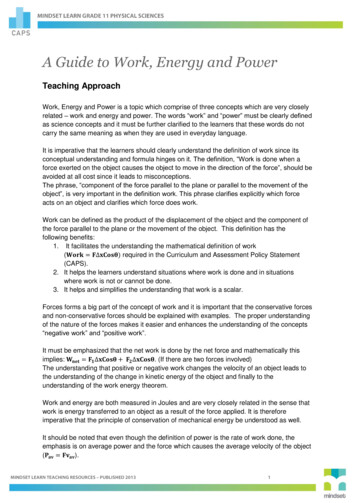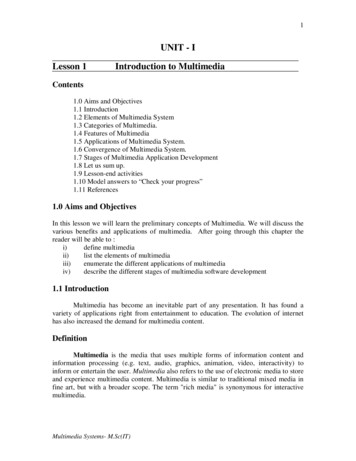
Transcription
1UNIT - ILesson 1Introduction to MultimediaContents1.0 Aims and Objectives1.1 Introduction1.2 Elements of Multimedia System1.3 Categories of Multimedia.1.4 Features of Multimedia1.5 Applications of Multimedia System.1.6 Convergence of Multimedia System.1.7 Stages of Multimedia Application Development1.8 Let us sum up.1.9 Lesson-end activities1.10 Model answers to “Check your progress”1.11 References1.0 Aims and ObjectivesIn this lesson we will learn the preliminary concepts of Multimedia. We will discuss thevarious benefits and applications of multimedia. After going through this chapter thereader will be able to :i)define multimediaii)list the elements of multimediaiii)enumerate the different applications of multimediaiv)describe the different stages of multimedia software development1.1 IntroductionMultimedia has become an inevitable part of any presentation. It has found avariety of applications right from entertainment to education. The evolution of internethas also increased the demand for multimedia content.DefinitionMultimedia is the media that uses multiple forms of information content andinformation processing (e.g. text, audio, graphics, animation, video, interactivity) toinform or entertain the user. Multimedia also refers to the use of electronic media to storeand experience multimedia content. Multimedia is similar to traditional mixed media infine art, but with a broader scope. The term "rich media" is synonymous for interactivemultimedia.Multimedia Systems- M.Sc(IT)
ar app aktion.png21.2 Elements of Multimedia SystemMultimedia means that computer information can be represented through audio,graphics, image, video and animation in addition to traditional media(text and graphics).Hypermedia can be considered as one type of particular multimedia application.Multimedia is a combination of content tal Clear app camera.pngVideoMultimedia Systems- M.Sc(IT)h
31.3 Categories of MultimediaMultimedia may be broadly divided into linear and non-linear categories. Linearactive content progresses without any navigation control for the viewer such as a cinemapresentation. Non-linear content offers user interactivity to control progress as used witha computer game or used in self-paced computer based training. Non-linear content isalso known as hypermedia content.Multimedia presentations can be live or recorded. A recorded presentation mayallow interactivity via a navigation system. A live multimedia presentation may allowinteractivity via interaction with the presenter or performer.Multimedia Systems- M.Sc(IT)
41.4 Features of MultimediaMultimedia presentations may be viewed in person on stage, projected,transmitted, or played locally with a media player. A broadcast may be a live or recordedmultimedia presentation. Broadcasts and recordings can be either analog or digitalelectronic media technology. Digital online multimedia may be downloaded or streamed.Streaming multimedia may be live or on-demand.Multimedia games and simulations may be used in a physical environment withspecial effects, with multiple users in an online network, or locally with an offlinecomputer, game system, or simulator.Enhanced levels of interactivity are made possible by combining multiple formsof media content But depending on what multimedia content you have it may varyOnline multimedia is increasingly becoming object-oriented and data-driven, enablingapplications with collaborative end-user innovation and personalization on multipleforms of content over time. Examples of these range from multiple forms of content onweb sites like photo galleries with both images (pictures) and title (text) user-updated, tosimulations whose co-efficient, events, illustrations, animations or videos are modifiable,allowing the multimedia "experience" to be altered without reprogramming.1.5 Applications of MultimediaMultimedia finds its application in various areas including, but not limited to,advertisements, art, education, entertainment, engineering, medicine, mathematics,business, scientific research and spatial, temporal applications.A few application areas of multimedia are listed below:Creative industriesCreative industries use multimedia for a variety of purposes ranging fromfine arts, to entertainment, to commercial art, to journalism, to media and softwareservices provided for any of the industries listed below. An individual multimediadesigner may cover the spectrum throughout their career. Request for their skillsrange from technical, to analytical and to creative.CommercialMuch of the electronic old and new media utilized by commercial artists ismultimedia. Exciting presentations are used to grab and keep attention inadvertising. Industrial, business to business, and interoffice communications areoften developed by creative services firms for advanced multimedia presentationsbeyond simple slide shows to sell ideas or liven-up training. Commercialmultimedia developers may be hired to design for governmental services andnonprofit services applications as well.Multimedia Systems- M.Sc(IT)
5Entertainment and Fine ArtsIn addition, multimedia is heavily used in the entertainment industry,especially to develop special effects in movies and animations. Multimedia gamesare a popular pastime and are software programs available either as CD-ROMs oronline. Some video games also use multimedia features.Multimedia applications that allow users to actively participate instead of justsitting by as passive recipients of information are called Interactive Multimedia.EducationIn Education, multimedia is used to produce computer-based trainingcourses (popularly called CBTs) and reference books like encyclopaedia andalmanacs. A CBT lets the user go through a series of presentations, text about aparticular topic, and associated illustrations in various information formats.Edutainment is an informal term used to describe combining education withentertainment, especially multimedia entertainment.EngineeringSoftware engineers may use multimedia in Computer Simulations foranything from entertainment to training such as military or industrial training.Multimedia for software interfaces are often done as collaboration betweencreative professionals and software engineers.IndustryIn the Industrial sector, multimedia is used as a way to help presentinformation to shareholders, superiors and coworkers. Multimedia is also helpfulfor providing employee training, advertising and selling products all over theworld via virtually unlimited web-based technologies.Mathematical and Scientific ResearchIn Mathematical and Scientific Research, multimedia is mainly used formodeling and simulation. For example, a scientist can look at a molecular modelof a particular substance and manipulate it to arrive at a new substance.Representative research can be found in journals such as the Journal ofMultimedia.MedicineIn Medicine, doctors can get trained by looking at a virtual surgery or theycan simulate how the human body is affected by diseases spread by viruses andbacteria and then develop techniques to prevent it.Multimedia Systems- M.Sc(IT)
6Multimedia in Public PlacesIn hotels, railway stations, shopping malls, museums, and grocery stores,multimedia will become available at stand-alone terminals or kiosks to provideinformation and help. Such installation reduce demand on traditional informationbooths and personnel, add value, and they can work around the clock, even in themiddle of the night, when live help is off duty.A menu screen from a supermarket kiosk that provide services rangingfrom meal planning to coupons. Hotel kiosk list nearby restaurant, maps of thecity, airline schedules, and provide guest services such as automated checkout.Printers are often attached so users can walk away with a printed copy of theinformation. Museum kiosk are not only used to guide patrons through theexhibits, but when installed at each exhibit, provide great added depth, allowingvisitors to browser though richly detailed information specific to that display.Check Your Progress 1List five applications of multimediaNotes: a) Write your answers in the space given below.b) Check your answers with the one given at the end of this lesson. 1.6 Convergence of Multimedia (Virtual Reality)At the convergence of technology and creative invention in multimedia is virtualreality, or VR. Goggles, helmets, special gloves, and bizarre human interfaces attempt toplace you “inside” a lifelike experience. Take a step forward, and the view gets closer,turn your head, and the view rotates. Reach out and grab an object; your hand moves infront of you. Maybe the object explodes in a 90-decibel crescendo as you wrap yourfingers around it. Or it slips out from your grip, falls to the floor, and hurriedly escapesthrough a mouse hole at the bottom of the wall.VR requires terrific computing horsepower to be realistic. In VR, your cyberspaceis made up of many thousands of geometric objects plotted in three-dimensional space:the more objects and the more points that describe the objects, the higher resolution andthe more realistic your view. As the user moves about, each motion or action requires thecomputer to recalculate the position, angle size, and shape of all the objects that make upyour view, and many thousands of computations must occur as fast as 30 times persecond to seem smooth.Multimedia Systems- M.Sc(IT)
7On the World Wide Web, standards for transmitting virtual reality worlds or“scenes” in VRML (Virtual Reality Modeling Language) documents (with the file nameextension .wrl) have been developed.Using high-speed dedicated computers, multi-million-dollar flight simulators builtby singer, RediFusion, and others have led the way in commercial application ofVR.Pilots of F-16s, Boeing 777s, and Rockwell space shuttles have made many dry runsbefore doing the real thing. At the California Maritime academy and other merchantmarine officer training schools, computer-controlled simulators teach the intricate loadingand unloading of oil tankers and container ships.Specialized public game arcades have been built recently to offer VR combat andflying experiences for a price. From virtual World Entertainment in walnut Greek,California, and Chicago, for example, BattleTech is a ten-minute interactive videoencounter with hostile robots. You compete against others, perhaps your friends, whoshare coaches in the same containment Bay. The computer keeps score in a fast andsweaty firefight. Similar “attractions” will bring VR to the public, particularly a youthfulpublic, with increasing presence during the 1990s.The technology and methods for working with three-dimensional images andfor animating them are discussed. VR is an extension of multimedia-it uses the basicmultimedia elements of imagery, sound, and animation. Because it requires instrumentedfeedback from a wired-up person, VR is perhaps interactive multimedia at its fullestextension.1.7 Stages of Multimedia Application DevelopmentA Multimedia application is developed in stages as all other software are beingdeveloped. In multimedia application development a few stages have to complete beforeother stages being, and some stages may be skipped or combined with other stages.Following are the four basic stages of multimedia project development :1. Planning and Costing : This stage of multimedia application is the first stagewhich begins with an idea or need. This idea can be further refined by outliningits messages and objectives. Before starting to develop the multimedia project, itis necessary to plan what writing skills, graphic art, music, video and othermultimedia expertise will be required.It is also necessary to estimate the time needed to prepare all elements ofmultimedia and prepare a budget accordingly. After preparing a budget, aprototype or proof of concept can be developed.2. Designing and Producing : The next stage is to execute each of the plannedtasks and create a finished product.3. Testing : Testing a project ensure the product to be free from bugs. Apart frombug elimination another aspect of testing is to ensure that the multimediaMultimedia Systems- M.Sc(IT)
8application meets the objectives of the project. It is also necessary to test whetherthe multimedia project works properly on the intended deliver platforms and theymeet the needs of the clients.4. Delivering : The final stage of the multimedia application development is to packthe project and deliver the completed project to the end user. This stage hasseveral steps such as implementation, maintenance, shipping and marketing theproduct.1.8 Let us sum upIn this lesson we have discussed the following pointsi)Multimedia is a woven combination of text, audio, video, images andanimation.ii)Multimedia systems finds a wide variety of applications in different areassuch as education, entertainment etc.iii)The categories of multimedia are linear and non-linear.iv)The stages for multimedia application development are Planning andcosting, designing and producing, testing and delivery.1.9 Lesson-end Activitiesi)ii)Create the credits for an imaginary multimedia production. Include severaloutside organizations such as audio mixing, video production, text baseddialogues.Review two educational CD-ROMs and enumerate their features.1.10 Model answers to “Check your progress”1. Your answers may include the )Engineeringv)Industryvi)Creative Industryvii)Mathematical and scientific Industryviii) Engineeringix)Commercial1.11 References1. “Multimedia Making it work” By Tay Vaughan2. “Multimedia in Practice – Technology and applications” By JeffcoatMultimedia Systems- M.Sc(IT)
9Lesson 2TextContents2.0 Aims and Objectives2.1 Introduction2.2 Multimedia Building blocks2.3 Text in multimedia2.4 About fonts and typefaces2.5 Computers and Text2.6 Character set and alphabets2.7 Font editing and design tools2.8 Let us sum up2.9 Lesson-end activities2.10 Model answers to “Check your progress”2.11 References2.0 Aims and ObjectivesIn this lesson we will learn the different multimedia building blocks. Later we willlearn the significant features of text.i)At the end of the lesson you will be able toii)List the different multimedia building blocksiii)Enumerate the importance of textiv)List the features of different font editing and designing tools2.1 IntroductionAll multimedia content consists of texts in some form. Even a menu text isaccompanied by a single action such as mouse click, keystroke or finger pressed in themonitor (in case of a touch screen). The text in the multimedia is used to communicateinformation to the user. Proper use of text and words in multimedia presentation willhelp the content developer to communicate the idea and message to the user.2.2 Multimedia Building BlocksAny multimedia application consists any or all of the following components :1. Text : Text and symbols are very important for communication in any medium.With the recent explosion of the Internet and World Wide Web, text has becomemore the important than ever. Web is HTML (Hyper text Markup language)originally designed to display simple text documents on computer screens, withoccasional graphic images thrown in as illustrations.Multimedia Systems- M.Sc(IT)
102. Audio : Sound is perhaps the most element of multimedia. It can provide thelistening pleasure of music, the startling accent of special effects or the ambienceof a mood-setting background.3. Images : Images whether represented analog or digital plays a vital role in amultimedia. It is expressed in the form of still picture, painting or a photographtaken through a digital camera.4. Animation : Animation is the rapid display of a sequence of images of 2-Dartwork or model positions in order to create an illusion of movement. It is anoptical illusion of motion due to the phenomenon of persistence of vision, and canbe created and demonstrated in a number of ways.5. Video : Digital video has supplanted analog video as the method of choice formaking video for multimedia use. Video in multimedia are used to portray realtime moving pictures in a multimedia project.2.3 Text in MultimediaWords and symbols in any form, spoken or written, are the most common systemof communication. They deliver the most widely understood meaning to the greatestnumber of people.Most academic related text such as journals, e-magazines are available in the WebBrowser readable form.2.4 About Fonts and FacesA typeface is family of graphic characters that usually includes many type sizesand styles. A font is a collection of characters of a single size and style belonging to aparticular typeface family. Typical font styles are bold face and italic. Other styleattributes such as underlining and outlining of characters, may be added at the userschoice.The size of a text is usually measured in points. One point is approximately 1/72of an inch i.e. 0.0138. The size of a font does not exactly describe the height or width ofits characters. This is because the x-height (the height of lower case character x) of twofonts may differ.Typefaces of fonts can be described in many ways, but the most commoncharacterization of a typeface is serif and sans serif. The serif is the little decoration atthe end of a letter stroke. Times, Times New Roman, Bookman are some fonts whichcomes under serif category. Arial, Optima, Verdana are some examples of sans seriffont. Serif fonts are generally used for body of the text for better readability and sansserif fonts are generally used for headings. The following fonts shows a few categoriesof serif and sans serif fonts.Multimedia Systems- M.Sc(IT)
11F F(Serif Font)(Sans serif font)Selecting Text fontsIt is a very difficult process to choose the fonts to be used in a multimediapresentation. Following are a few guidelines which help to choose a font in a multimediapresentation. As many number of type faces can be used in a single presentation, this conceptof using many fonts in a single page is called ransom-note topography.For small type, it is advisable to use the most legible font.In large size headlines, the kerning (spacing between the letters) can be adjustedIn text blocks, the leading for the most pleasing line can be adjusted.Drop caps and initial caps can be used to accent the words.The different effects and colors of a font can be chosen in order to make the textlook in a distinct manner.Anti aliased can be used to make a text look gentle and blended.For special attention to the text the words can be wrapped onto a sphere or bentlike a wave.Meaningful words and phrases can be used for links and menu items.In case of text links(anchors) on web pages the messages can be accented.The most important text in a web page such as menu can be put in the top 320 pixels.Check Your Progress 1List a few fonts available in your computer.Notes: a) Write your answers in the space given below.b) Check your answers with the one given at the end of this lesson. Multimedia Systems- M.Sc(IT)
122.5 Computers and text:Fonts :Postscript fonts are a method of describing an image in terms of mathematicalconstructs (Bezier curves), so it is used not only to describe the individual characters of afont but also to describe illustrations and whole pages of text. Since postscript makes useof mathematical formula, it can be easily scaled bigger or smaller.Apple and Microsoft announced a joint effort to develop a better and fasterquadratic curves outline font methodology, called truetype In addition to printingsmooth characters on printers, TrueType would draw characters to a low resolution (72dpi or 96 dpi) monitor.2.6 Character set and alphabets:ASCII Character setThe American standard code for information interchange (SCII) is the 7bit character coding system most commonly used by computer systems in theUnited states and abroad. ASCII assigns a number of value to 128 characters,including both lower and uppercase letters, punctuation marks, Arabic numbersand math symbols. 32 control characters are also included. These controlcharacters are used for device control messages, such as carriage return, line feed,tab and form feed.The Extended Character setA byte which consists of 8 bits, is the most commonly used building blockfor computer processing. ASCII uses only 7 bits to code is 128 characters; the 8thbit of the byte is unused. This extra bit allows another 128 characters to beencoded before the byte is used up, and computer systems today use these extra128 values for an extended character set. The extended character set is commonlyfilled with ANSI (American National Standards Institute) standard characters,including frequently used symbols.UnicodeUnicode makes use of 16-bit architecture for multilingual text andcharacter encoding.Unicode uses about 65,000 characters from all knownlanguages and alphabets in the world.Several languages share a set of symbols that have a historically relatedderivation, the shared symbols of each language are unified into collections ofMultimedia Systems- M.Sc(IT)
13symbols (Called scripts). A single script can work for tens or even hundreds oflanguages.Microsoft, Apple, Sun, Netscape, IBM, Xerox and Novell are participatingin the development of this standard and Microsoft and Apple have incorporatedUnicode into their operating system.2.7 Font Editing and Design toolsThere are several software that can be used to create customized font. These toolshelp an multimedia developer to communicate his idea or the graphic feeling. Usingthese software different typefaces can be created.In some multimedia projects it may be required to create special characters. Using thefont editing tools it is possible to create a special symbols and use it in the entire text.Following is the list of software that can be used for editing and creating fonts: FontographerFontmongerCool 3D textSpecial font editing tools can be used to make your own type so you cancommunicate an idea or graphic feeling exactly. With these tools professionaltypographers create distinct text and display faces.1. Fontographer:It is macromedia product, it is a specialized graphics editor for bothMacintosh and Windows platforms. You can use it to create postscript,truetype and bitmapped fonts for Macintosh and Windows.2. Making Pretty Text:To make your text look pretty you need a toolbox full of fonts and specialgraphics applications that can stretch, shade, color and anti-alias yourwords into real artwork. Pretty text can be found in bitmapped drawingswhere characters have been tweaked, manipulated and blended into agraphic image.3. Hypermedia and Hypertext:Multimedia is the combination of text, graphic, and audio elements into asingle collection or presentation – becomes interactive multimedia whenyou give the user some control over what information is viewed and whenit is viewed.Multimedia Systems- M.Sc(IT)
14When a hypermedia project includes large amounts of text or symboliccontent, this content can be indexed and its element then linked together toafford rapid electronic retrieval of the associated information.When text is stored in a computer instead of on printed pages thecomputer’s powerful processing capabilities can be applied to make thetext more accessible and meaningful. This text can be called as hypertext.4. Hypermedia Structures:Two Buzzwords used often in hypertext are link and node. Links areconnections between the conceptual elements, that is, the nodes that maconsists of text, graphics, sounds or related information in the knowledgebase.5. Searching for words:Following are typical methods for a word searching in hypermediasystems: Categories, Word Relationships, Adjacency, Alternates,Association, Negation, Truncation, Intermediate words, Frequency.Check Your Progress 2List a few font editing tools.Notes: a) Write your answers in the space given below.b) Check your answers with the one given at the end of this lesson. 2.8 Let us sum up.In this lesson we have learnt the followingi)The multimedia building blocks such as text, audio, video, images,animationii)The importance of text in multimediaiii)The difference between fonts and typefacesiv)Character sets used in computers and their significancev)The font editing software which can be used for creating new fonts and thefeatures of such software.2.9 Lesson-end activitiesCreate a new document in a word processor. Type a line of text in the wordprocessor and copy it five times and change each line into a different font. Finallychange the size of each line to 10 pt, 12pt, 14pt etc. Now distinguish each fontfamily and the typeface used in each font.Multimedia Systems- M.Sc(IT)
15.2.10 Model answers to “Check your progress”1. Your answers may include the followingArialTimes New RomanGaramondScriptCourierGeorgiaBook AntiquaCentury Gothic2. Your answer may include the followinga) Fontmongerb) Cool 3D text2.11 References1. "Multimedia:Concepts and Practice" By Stephen McGloughlin2. ”Multimedia Computing, Communication and application” By Steinmetz andKlara Nahrstedt.3. “Multimedia Making it work” By Tay Vaughan4. “Multimedia in Practice – Technology and applications” By JeffcoatMultimedia Systems- M.Sc(IT)
16Lesson 3AudioContents3.0 Aims and Objectives3.1 Introduction3.2 Power of Sound3.3 Multimedia Sound Systems3.4 Digital Audio3.5 Editing Digital Recordings3.6 Making MIDI Audio3.7 Audio File Formats3.8 Red Book Standard3.9 Software used for Audio3.10 Let us sum up3.11 Lesson-end activities3.12 Model answers to “Check your progress”3.13 References3.0 Aims and ObjectivesIn this lesson we will learn the basics of Audio. We will learn how a digital audiois prepared and embedded in a multimedia system.At the end of the chapter the learner will be able to :i)ii)iii)iv)Distinguish audio and soundPrepare audio required for a multimedia systemThe learner will be able to list the different audio editing softwares.List the different audio file formats3.1 IntroductionSound is perhaps the most important element of multimedia. It is meaningful“speech” in any language, from a whisper to a scream. It can provide the listeningpleasure of music, the startling accent of special effects or the ambience of a moodsetting background. Sound is the terminology used in the analog form, and the digitizedform of sound is called as audio.Multimedia Systems- M.Sc(IT)
173.2 Power of SoundWhen something vibrates in the air is moving back and forth it creates wave ofpressure. These waves spread like ripples from pebble tossed into a still pool and when itreaches the eardrums, the change of pressure or vibration is experienced as sound.Acoustics is the branch of physics that studies sound. Sound pressure levels aremeasured in decibels (db); a decibel measurement is actually the ratio between a chosenreference point on a logarithmic scale and the level that is actually experienced.3.3 Multimedia Sound SystemsThe multimedia application user can use sound right off the bat on both theMacintosh and on a multimedia PC running Windows because beeps and warning soundsare available as soon as the operating system is installed. On the Macintosh you canchoose one of the several sounds for the system alert. In Windows system sounds areWAV files and they reside in the windows\Media subdirectory.There are still more choices of audio if Microsoft Office is installed. Windows makes useof WAV files as the default file format for audio and Macintosh systems use SND asdefault file format for audio.3.4 Digital AudioDigital audio is created when a sound wave is converted into numbers – a processreferred to as digitizing. It is possible to digitize sound from a microphone, a synthesizer,existing tape recordings, live radio and television broadcasts, and popular CDs. You candigitize sounds from a natural source or prerecorded.Digitized sound is sampled sound. Ever nth fraction of a second, a sample ofsound is taken and stored as digital information in bits and bytes. The quality of thisdigital recording depends upon how often the samples are taken.3.4.1 Preparing Digital Audio FilesPreparing digital audio files is fairly straight forward. If you have analog sourcematerials – music or sound effects that you have recorded on analog media such ascassette tapes. The first step is to digitize the analog material and recording it onto a computerreadable digital media. It is necessary to focus on two crucial aspects of preparing digital audio files:o Balancing the need for sound quality against your available RAM andHard disk resources.o Setting proper recording levels to get a good, clean recording.Multimedia Systems- M.Sc(IT)
18Remember that the sampling rate determines the frequency at which samples willbe drawn for the recording. Sampling at higher rates more accurately captures the highfrequency content of your sound. Audio resolution determines the accuracy with which asound can be digitized.Formula for determining the size of the digital audioMonophonic Sampling rate * duration of recording in seconds * (bit resolution / 8) * 1Stereo Sampling rate * duration of recording in seconds * (bit resolution / 8) * 2 The sampling rate is how often the samples are taken. The sample size is the amount of information stored. This is called as bitresolution. The number of channels is 2 for stereo and 1 for monophonic. The time span of the recording is measured in seconds.3.5 Editing Digital RecordingsOnce a recording has been made, it will almost
Oct 14, 2001 · is necessary to plan what writing skills, graphic art, music, video and other multimedia expertise will be required. It is also necessary to estimate the time needed to prepare all elements of multimedia and prepare a budget accordingly. After preparing a bud




